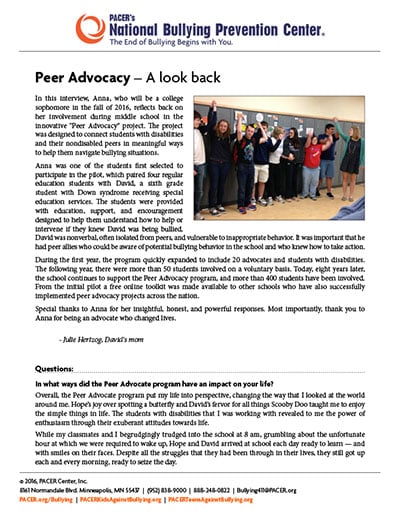
Peer advocacy is a program centered around inclusion and designed to educate students on speaking out on behalf of students with intellectual, developmental, or other disabilities. It is is a unique approach that empowers students to protect those targeted by bullying and to provide social inclusion opportunities.
A peer advocate is a student who looks out for other students who are being bullied, are vulnerable to being hurt or harmed, or who are isolated from other students. Peer advocates help out by making sure that they are included and protected from harm. The peer advocate program teaches students about different disabilities and encourages them to befriend their peers with disabilities. Peer Advocates also learn how to use their strengths in order to effectively advocate for those who are targeted by bullying.
Most students don’t like to see bullying, but they may not know what to do when it happens. Peer advocacy — speaking out on the behalf of others — is a unique approach that empowers students to protect those targeted by bullying.
Peer advocacy is effective for two reasons:

In this interview, Anna, a college sophomore in the fall of 2016, reflects back on her involvement during middle school in the innovative “Peer Advocacy” project. The project was designed to connect students with disabilities and their nondisabled peers in meaningful ways to help them navigate bullying situations.
Encourage the adults in your school, such as your principal, school counselor, or teacher, to consider a “Peer Advocacy” project at school.
DETERMINE THE PARTICIPANTS: In exploring a peer advocacy model in your school, consider who the adult leader should be, often it’s a teacher who has a relationship with students in the special education setting. Then, define which students with disabilities could benefit from peer intervention and inclusive practices. The next step is invite students to be peer advocates. When recruiting, its encouraged to look across the school environment and be sure to have representation from a diverse group of individuals.
PROVIDE EDUCATION: The peer advocates should be educated on:
TALK ABOUT APPROPRIATE ACTIONS TO INTERVENE: Intervention strategies can be tailored for each situation, student, and advocate. Some advocates will feel comfortable with direct interventions, such as telling the person bullying to stop. Others may want to approach indirectly, such as supporting the person after an incident or reporting it to the adult leader. Encourage students to explore their own strengths. Help them with identify the intervention or action steps they would be most comfortable with implementing.
BENEFITS TO STUDENTS: The benefits of peer advocacy include not only having a strategy to keep students with disabilities safe, but also providing opportunities for social inclusion. Student advocates also benefit from learning skills such as empathy, inclusion, leadership, and acceptance.
Helpful resources include:
In this 4-minute video, program participants from the Watertown-Mayer, Minn., school district share their experiences and viewpoints on their participation in the peer advocacy project.
Most important: Be a friend!
Watch out for those students, with and without disabilities, who might need your help and have their backs.
Tips to be a friend include:
If you know that someone is being teased, hurt, or harmed in any manner, you can:
Students who have been peer advocates said, “When I saw bullying happen, I…”
Student advocates share:
“I learned that even though I am only one person I can change society.”
“Being a peer advocate makes me more aware when someone is not being included and it is a lot easier to include them and still have them feel comfortable. I have learned that there is so much more to me than just who I was before.”
“Before I saw people give the kids with disabilities bad looks and didn’t stand up for them, now I will stand up for them.”
“Before Peer Advocacy, kids were eating alone, now we are sitting with them and hanging out.”
“Peer advocates should spread around the world.”
“Later in life I’ll be able to say I was a peer advocate, I made a difference! Will you?”
“I love being a Peer Advocate, it’s so much fun. I love it and am happy I joined. Before it was not as fun being in nothing then I heard about Peer Advocates and then that inspired me and I did it for the kids with disabilities and they rock!”
“I think it’s important to be a Peer Advocate to let kids know they’re not alone and that others really do have their backs. Even though some treat them differently, they are just like everyone else. They should be treated the same, too. From this experience I learned all that. I think others should consider this too.”
Insights and advice from students as they think through how to respond to real life bullying situations. In this video middle school students from a “peer advocacy” group explore how to handle a scenario in which a student with down syndrome is being bullied.
Get a behind the scenes look at the inspiration for the peer advocacy project, which connects students with and without disabilities.